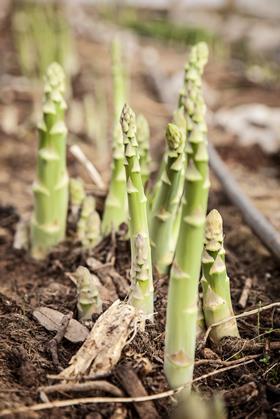
There is always a fine line between the PR storm that heralds the start of the British asparagus season and the weather needed to produce the actual crop – and 2016 has so far been no different.
Mild temperatures throughout winter caused havoc for many British crops, including early asparagus, with the first limited volumes of heated and tunnel crop from Wye Valley appearing as early as January. The delayed cold snap at the start of spring then had the opposite effect on the asparagus maincrop – the season is now running roughly two weeks behind and supply is tight across retail and wholesale.
Henry Chinn, of Cobrey Farms, explains: “The season is well behind due to the cold temperatures. We should be into full production at this point, and instead we’re probably around two weeks behind. We have crops in Suffolk and Norfolk as well and it’s the same there. Supply is very tight at the moment. “We had the first small volumes in January, which is unheard of. Then it got cold during March and April so the main crop is now late. It’s been a tricky season,” he adds.
S&A Produce’s group operations director, Jan-Willem Naerebout, says the season is “definitely later” than last year, with the cold weather holding the crop back. “The mini-tunnels are paying dividend this year. Due to the weather, curvature has been a lot higher than normal and also very recently we have been affected by frost damage,” he says. “Cold day and night temperatures are limiting supply at this early stage in the season compared to last year. A sudden rise in night-time temperatures could result in a crop flush.”
Short-term supply aside, asparagus is still enjoying growing popularity: Jamie Petchell, director at asparagus and soft-fruit specialist Global Plant Genetics, notes that it is moving from a niche product into something much more important.
“Picking up on discussions with important players around the world, there are two key consumer trends that I can identify,” he says. “One is a general movement to more and more green asparagus consumption. The white product dominates in many markets but even in those places, we are seeing more green asparagus being planted.
“The second one is about convenience and reduced preparation time in the kitchen. This is related to the first point due to the fact that green asparagus is much easier to prepare than white, as it requires no peeling prior to cooking. In addition, we are witnessing a general move in the UK towards the consumption of more tips than spears. Once more, this means a higher level of convenience for the consumer.”
Coloured asparagus is a noticeable area of innovation in the category at the moment, and Petchell sees potential for further growth as the “asparagus connoisseur will then seek ways in which to widen their eating experience,” he adds. “We are now seeing improved purple varieties that are more suited to production in the UK. As a result, they are now potentially a more profitable option for UK production.”
Chinn, whose business supplies some volumes of purple and white asparagus, says demand is higher in Europe, whereas the UK market seems to prefer green. “We supply some white and purple asparagus and there is good demand, but it’s pretty niche,” he says.
A real variety
S&A Produce is trialling a “significant area of two varieties” – Tallems and Portlim – according to Jan-Willem Naerebout. “Portlim in particular is an interesting variety as it was developed specifically for green asparagus rather than the traditional white varieties, which are used for green asparagus,” he says. “We will closely monitor the shape and colour of the spears but also earliness and yield potential.” S&A is also trialling significant areas of land with techniques to reduce water runoff and soil erosion, adds Naerebout.
Meanwhile Jamie Petchell, of Global Plant Genetics, says the company has a number of new selections from both existing breeders and newer crossing programmes. “These are all numbered hybrids at the moment but we are planning to name and release them post this asparagus harvest season,” he says.



